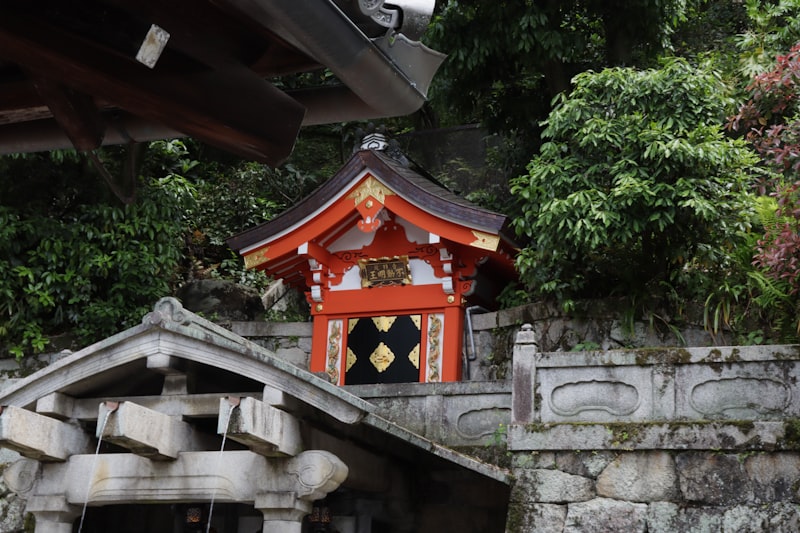Imagine wandering through the iconic Fushimi Inari Shrine, where thousands of vermillion torii gates form a mystical pathway up the sacred Mount Inari. Each gate signifies a prayer, a wish, echoing the spiritual essence of Kyoto. As you stroll along the Philosopher’s Path, lined with cherry blossoms in spring and fiery maples in autumn, you’re transported into a poetic realm where nature and philosophy converge.
Kyoto’s cultural heartbeat pulses strongest in its UNESCO World Heritage Sites like Kinkaku-ji, the Golden Pavilion, adorned with gold leaf that shimmers in the sunlight. Nearby, the serene Ryoan-ji Temple’s rock garden captivates with its minimalist perfection, inviting quiet contemplation amidst carefully raked gravel and 15 precisely placed rocks.
The city’s charm extends to its culinary traditions, where kaiseki dining offers a symphony of seasonal flavors meticulously prepared to reflect Kyoto’s changing seasons. Each dish is not just a meal but a masterpiece, crafted with reverence for local ingredients and centuries-old culinary techniques.

Art enthusiasts find solace in Kyoto’s vibrant arts scene, from Nishijin weaving to delicate ceramics. The city breathes life into traditional crafts, ensuring they thrive in a modern world. As evening descends, Gion district comes alive with the allure of Geisha performances, a glimpse into a world where grace and tradition blend effortlessly.
In Kyoto, every alley, every shrine, every tea ceremony is a testament to a culture that cherishes its past while embracing the future. It’s a city where the ancient and the contemporary coexist harmoniously, offering visitors an unforgettable journey through time and tradition.
Unveiling Kyoto’s Hidden Treasures: Cultural Marvels Beyond Temples
Imagine wandering through the narrow alleys of Gion, where geishas gracefully glide from teahouse to teahouse, preserving traditions that have spanned centuries. Each step echoes with the whispers of history, as old wooden machiya houses stand testament to Kyoto’s architectural legacy.
Venture further into the city’s labyrinthine streets, and you’ll stumble upon the Nishiki Market, a bustling arcade where artisans and vendors showcase Kyoto’s culinary prowess. Here, the air is thick with the aroma of freshly grilled yakitori and the sight of colorful pickled vegetables arranged like edible mosaics.
For art enthusiasts, Kyoto’s museums offer a glimpse into the soul of Japanese creativity. The Kyoto International Manga Museum houses a treasure trove of graphic novels, inviting visitors to explore the evolution of this beloved art form. Meanwhile, the Kyoto National Museum showcases exquisite textiles and ceramics that embody the craftsmanship of bygone eras.
Beyond the city center, Arashiyama emerges as a verdant sanctuary where nature intertwines seamlessly with cultural heritage. The iconic Arashiyama Bamboo Grove envelops visitors in a serene symphony of rustling leaves, offering a tranquil retreat from urban bustle. Nearby, the historic Tenryu-ji Temple and its meticulously landscaped gardens invite contemplation and reflection.
Kyoto’s hidden treasures are not confined to its urban sprawl. In the outskirts, the Fushimi Inari Shrine beckons with its iconic vermilion torii gates that snake through a forested mountainside. This sacred site embodies Kyoto’s spiritual essence, where each gate marks a passage into the divine.
In essence, Kyoto’s cultural marvels transcend mere sightseeing; they offer a profound journey into Japan’s soul. Whether exploring ancient traditions in Gion or immersing oneself in the serenity of Arashiyama, every corner of Kyoto reveals a story waiting to be discovered—a testament to the enduring allure of this city of hidden treasures.
Kyoto’s Living Heritage: Exploring Timeless Cultural Marvels

Imagine strolling through narrow streets lined with traditional wooden machiya houses, each whispering tales of samurai and geisha who once graced these ancient quarters. Kyoto’s preservation of these architectural gems offers a glimpse into Japan’s feudal past, where every stone and roof tile tells a story of craftsmanship and heritage.
The city’s temples stand as silent sentinels of spirituality and artistry. From the iconic Kinkaku-ji, adorned in shimmering gold leaf that reflects upon the tranquil waters of its surrounding pond, to the contemplative Ryoan-ji with its enigmatic rock garden, Kyoto’s temples invite contemplation and awe. These sacred spaces not only house centuries-old Buddhist relics but also serve as living centers of Zen practice, where visitors can participate in meditation sessions to experience a profound connection with Japan’s spiritual essence.
Kyoto’s cultural calendar brims with vibrant festivals that celebrate the changing seasons and ancient traditions. Whether it’s the cherry blossom-filled revelry of Hanami in spring or the mesmerizing Gion Matsuri in summer, each festival is a testament to Kyoto’s commitment to preserving its cultural heritage through lively rituals and performances.
Moreover, Kyoto is a haven for traditional arts and crafts. From delicate tea ceremonies that embody harmony and respect to intricate kimono weaving that showcases unparalleled craftsmanship, every art form in Kyoto is a testament to meticulous attention to detail and unwavering dedication to preserving Japan’s cultural legacy.
In essence, Kyoto’s living heritage transcends mere historical artifacts; it’s a testament to Japan’s enduring spirit and its commitment to honoring the past while embracing the future. Whether you’re wandering through a moss-covered temple garden or savoring the umami flavors of Kyoto cuisine, every moment spent in this cultural marvel is an invitation to immerse yourself in the essence of Japan’s timeless allure.
Secrets of Kyoto’s Cultural Marvels: A Journey Through Tradition
In the heart of Kyoto lies the Gion district, a realm where geishas gracefully tread, embodying Japan’s traditional arts. Here, amidst wooden teahouses and lantern-lit alleys, one can witness the intricate dance of culture and history. The streets themselves seem to narrate tales of bygone eras, echoing the footsteps of samurais and the whispers of tea ceremonies.
Venturing further, Kyoto’s temples emerge as architectural marvels steeped in spiritual significance. The Fushimi Inari Shrine, adorned with thousands of vermillion torii gates, invites visitors on a mystical journey through sacred pathways. Each gate represents a passage into a realm where spirituality and natural beauty intertwine, offering a glimpse into Japan’s profound reverence for its deities.
In contrast, the serene gardens of Kyoto, such as the iconic Ryoanji Temple’s Zen garden, provide a haven of tranquility and contemplation. The carefully raked gravel and strategically placed rocks create an oasis where silence speaks louder than words—a sanctuary where one can immerse oneself in the essence of Zen philosophy.
Art enthusiasts find their muse in Kyoto’s museums and galleries, where masterpieces of traditional Japanese artistry are preserved. From delicate silk kimonos to exquisite porcelain pottery, each artifact tells a story of craftsmanship passed down through generations. These galleries not only showcase Japan’s artistic prowess but also serve as gateways to understanding the cultural depth woven into every brushstroke and thread.
Kyoto’s culinary scene also mirrors its cultural diversity, with centuries-old ryotei (traditional restaurants) offering kaiseki, a culinary art form that elevates dining to a spiritual experience. Each dish, meticulously crafted to harmonize flavors and textures, pays homage to seasonal ingredients and ancient culinary traditions.
For travelers, Kyoto is more than a city—it is a living testament to Japan’s enduring traditions and the resilience of its cultural heritage. Exploring its marvels is like embarking on a journey through time, where each discovery enriches the soul and deepens appreciation for the beauty of tradition.
Kyoto’s Modern Icons: Merging Innovation with Cultural Marvels
Imagine strolling through the streets of Kyoto, where amidst the serene ambiance of ancient shrines, you encounter striking examples of modern architecture like the Kyoto Station. This architectural marvel, resembling a futuristic spaceship, serves not only as a transportation hub but also as a symbol of Kyoto’s embrace of contemporary design.
Moreover, Kyoto isn’t just about preserving its past; it thrives on innovation in various sectors. The city hosts world-renowned research institutes and universities, fostering groundbreaking advancements in technology and science. From robotics to environmental sustainability, Kyoto remains at the forefront of pioneering initiatives that shape the future.
One cannot overlook the juxtaposition of ancient and modern in Kyoto’s culinary scene either. While savoring traditional Kyoto cuisine meticulously prepared with centuries-old recipes, one can easily find Michelin-starred restaurants experimenting with avant-garde culinary techniques. It’s a gastronomic journey where history meets innovation on every plate.
Beyond its physical manifestations, Kyoto embodies a mindset where tradition serves as a foundation for innovation rather than a hindrance. This approach is evident in the city’s arts and crafts, where traditional methods are revitalized through contemporary interpretations, appealing to both local connoisseurs and international aficionados.
Beyond Temples: Kyoto’s Cultural Marvels in Urban Splendor
Step into the vibrant streets of Gion, where geishas gracefully glide along narrow alleys lined with traditional machiya houses. This historic district embodies Kyoto’s cultural essence, preserving centuries-old customs through its tea houses, theaters, and exclusive ochaya (geisha houses). Here, every glimpse offers a glimpse into Japan’s rich artistic legacy, where the art of conversation and hospitality thrives in a setting frozen in time.
Venture further into the heart of Kyoto’s cultural tapestry, and you’ll encounter the exquisite beauty of Kinkaku-ji, the famed Golden Pavilion. Reflecting on the surface of Kyoko-chi Pond, this shimmering structure stands as a testament to the city’s dedication to preserving architectural wonders amidst lush greenery. Each season paints a different picture here, from cherry blossoms in spring to fiery maple leaves in autumn, making it a perennial attraction for visitors seeking awe-inspiring beauty.
For those intrigued by the intersection of tradition and innovation, Kyoto’s modern art scene offers a glimpse into contemporary interpretations of ancient crafts. Museums like the Kyoto International Manga Museum celebrate Japan’s global influence in pop culture, while galleries showcase avant-garde works that push the boundaries of artistic expression.
Beyond its physical beauty, Kyoto’s cultural allure extends to its culinary traditions, where kaiseki ryori (traditional multi-course meals) and tea ceremonies transcend mere sustenance to become spiritual experiences. The city’s bustling markets and quaint cafes offer a sensory journey through flavors that have been perfected over generations.
In essence, Kyoto’s urban splendor goes beyond its temples; it’s a living testament to Japan’s cultural heritage, where every corner tells a story of resilience, artistry, and reverence for the past. Whether you wander through historic streets or marvel at modern interpretations of ancient crafts, Kyoto invites you to discover a city where tradition and innovation harmoniously coexist, creating an experience that resonates long after you’ve left its enchanting embrace.
Kyoto’s Artistic Renaissance: Contemporary Flair Meets Cultural Marvels
Imagine wandering through Gion, where traditional tea houses and geisha performances still enchant visitors today. Yet, alongside these historic treasures, modern art galleries and experimental theaters are flourishing. It’s a city where centuries-old temples share the skyline with sleek, minimalist art spaces, each venue a testament to Kyoto’s dual identity—a place where past and present converge in harmony.
The city’s artistic revival isn’t just confined to physical spaces; it permeates Kyoto’s creative soul. Artists here draw inspiration from the serene landscapes of Arashiyama and the vibrant bustle of Nishiki Market, infusing their works with the essence of Kyoto’s diverse tapestry. It’s a fusion that captivates both locals and global travelers, offering a glimpse into a culture that cherishes both tradition and innovation.
In Kyoto, every stroke of a calligraphy brush and every delicate kimono pattern tells a story of craftsmanship passed down through generations. Yet, these traditions aren’t stagnant; they evolve alongside contemporary trends. Imagine traditional ceramics adorned with modern motifs or ancient woodblock prints reimagined in bold, new colors—the city’s artists embrace change while honoring their artistic roots.
Kyoto’s artistic renaissance isn’t just about creating beauty; it’s about preserving a cultural legacy while pushing boundaries. It invites you to explore, to ponder, and to witness a city where every corner tells a tale, where every artwork whispers secrets of the past and visions of the future. In Kyoto, art isn’t just something you observe; it’s an experience that immerses you in a dialogue between history and innovation, leaving you inspired and in awe of this dynamic city’s creative spirit.
From Geishas to Zen Gardens: Kyoto’s Top Cultural Marvels
Geishas, the epitome of grace and elegance, are a quintessential part of Kyoto’s cultural fabric. These highly skilled entertainers captivate with their traditional performances of music, dance, and conversation. Encountering a Geisha in the historic Gion district is like stepping into a bygone era, where every gesture and movement exudes artistry and tradition.
Zen gardens, meticulously designed havens of tranquility, offer a stark contrast to Kyoto’s bustling streets. These gardens, such as the famous Ryoanji Temple’s rock garden, are crafted to evoke a sense of harmony and contemplation. With their carefully placed rocks and raked gravel, they invite visitors to meditate and reflect, providing a serene escape from the city’s hustle and bustle.

Kyoto’s temples and shrines are architectural masterpieces that reflect centuries of spiritual devotion. The Kinkakuji Temple, adorned in shimmering gold leaf, stands as a symbol of opulence and serenity amidst lush greenery. Meanwhile, the Fushimi Inari Shrine with its thousands of vermillion torii gates is not just a place of worship but a stunning testament to faith and cultural reverence.
Traditional tea ceremonies, rooted in Zen philosophy, offer a glimpse into Japanese etiquette and hospitality. Participating in a tea ceremony in Kyoto is a profound experience where every gesture, from the preparation of matcha to the delicate handling of utensils, carries deep cultural significance.
Kyoto’s festivals, such as the vibrant Gion Matsuri, celebrate the city’s heritage with colorful processions and traditional performances. These lively events bring together locals and tourists alike, fostering a sense of community and cultural pride.
Exploring Kyoto’s cultural marvels is like unraveling the threads of Japan’s history and traditions. Each experience, whether encountering a Geisha, wandering through a Zen garden, or participating in a tea ceremony, offers a profound insight into the soul of this ancient city. In Kyoto, the past seamlessly blends with the present, creating an unforgettable journey through Japan’s cultural tapestry.
Frequently Asked Questions
What are some lesser-known cultural attractions in Kyoto?
Discover lesser-known cultural gems in Kyoto beyond popular sites like temples and gardens. Explore hidden teahouses in quaint neighborhoods, attend intimate traditional theater performances, and visit local artisan workshops for unique crafts.
What are the must-visit temples and shrines in Kyoto?
Discover the essential temples and shrines in Kyoto with our guide. Explore iconic sites like Kinkaku-ji (Golden Pavilion), Fushimi Inari Taisha, and Kiyomizu-dera, renowned for their historical significance and stunning architecture.
What are the best times to visit Kyoto’s cultural festivals?
Discover the optimal times to experience Kyoto’s vibrant cultural festivals with our concise guide. Learn when key events like Gion Matsuri and Jidai Matsuri occur to make the most of your visit, immersing yourself in Japan’s rich cultural heritage.
How do I navigate Kyoto’s cultural etiquette as a visitor?
Learn how to navigate Kyoto’s cultural etiquette as a visitor with our concise guide. Discover essential tips to respectfully engage with local customs, ensuring a smooth and enriching experience during your stay.
How can I experience a traditional tea ceremony in Kyoto?
Learn how to participate in a traditional tea ceremony in Kyoto with our concise guide. Discover the essential steps and etiquette to immerse yourself in this cultural experience.


